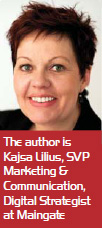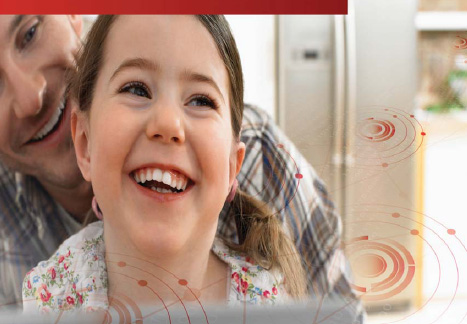The Internet of Things (IoT), connected devices and big data are buzzwords in the energy industry. Words that scare. What to do, when to do and how to do? As Kajsa Lilius of Maingate says, the amount of data generated today is enormous and there is a strong need for guidance across the digital landscape.
 The number of connected devices that will be online in a couple of years will, according to Ericsson, be around 50 million; this prediction alone has a ripple effect. The need for appliances in the home to be fitted with smart energy technology and the need for the systems in place in the home to record and send accurate consumption data to the provider are two of the many things that the industry is currently grappling with.
The number of connected devices that will be online in a couple of years will, according to Ericsson, be around 50 million; this prediction alone has a ripple effect. The need for appliances in the home to be fitted with smart energy technology and the need for the systems in place in the home to record and send accurate consumption data to the provider are two of the many things that the industry is currently grappling with.
Or seen another way, whilst there are a host of challenges, there are also many opportunities on the horizon.
The digital landscape is all about content that is relevant to the target group and it requires engagement with consumers, typically online. However, many utilities continue to be swamped with issues concerning the technology around smart
meters, protocols and methods of communication between the meter and the household and the need for standardisation and compliance with regulatory demands. The fact is the data is already out there and the technology for collecting, delivering and analysing the data is also in place and consumers are waiting. Within the trade we call it M2M.
We are all consumers of energy, some more than others. The availability and access to energy 24/7 is something that we don’t give a second thought to. We simply plug it in and expect it to work. Do we as consumers have any relationship with the amount of energy we use? Do we understand the impact of our usage patterns? And do we really care?
The impact of our energy usage is something that we all are being made more and more aware of, whether it is global warming, energy shortages, and alternative fuel sources given that our planet’s resources will not last for ever.
Even if we all know and understand that we should use less energy and that we need to do something, this something is not clear. What do we know about energy and how it is even measured? You probably know how much one litre of milk cost and how much you and your family consume for a week, but do you know how much energy you and your family use in a week and what it costs?
We know that information leads to knowledge, and that knowledge leads to the power to change. With knowledge, a change in behaviour is inevitable but when and how knowledge is delivered and received will affect different kinds of behavioural change. For example, if you receive information about your household’s energy usage once a month together with the bill you will probably compare it to the previous month and perhaps also with the same month the
previous year. If there are any significant changes you will most likely notice it and if the usage is lower than before, great! If it’s higher you will probably wonder why. And you will most likely never understand the cause of the difference, since the information shared spans an entire month. Given that one’s ability to act is limited, some people don’t even bother to look at their bills at all. It costs what it costs.
Appealing information
Information needs to be delivered in a way that appeals to you. It has to be relevant – appealing to your values, highlighting £ costs, environment, convenience, etc. It has to be in real time – creating an understanding of cause and effect and it has to be social – comparable with friends and family or others with similar energy usage patterns. With the right trigger, behaviour can change. For example, if your energy bill increases and your income stays the same you will most likely think that you need to do something in order to reduce cost but will you know what to do, when and how?
If we put energy consumption data into the context of today’s information distribution models we can see that the way the utility companies use and distribute their data is outdated. Today, we as consumers are more and more likely to share data about ourselves, our habits and even our health in exchange for tailormade services, which have been personalised and sent directly to the platform of our choosing.
When it comes to energy usage, typically I will only know how I use energy with a time lag and it will not give me much more information or analysis than some historical usage information. It will not give me any tools to change my behaviour, reduce my consumption, reduce my carbon footprint and save money in the process. But if I had the data that was relevant for me, in a context that I could understand and accompanied by suggestions of how I can act to
reduce my consumption, it is more likely that I would do so. Taking it a step further, once I have noticed the change that my behaviour has caused, I may be encouraged to take bolder initiatives, and even share these experiences.
Energy consumers will then become energy citizens. This is consumer interaction in the digital era. This is innovation. Today marketing professionals struggle to create loyalty among existing customers and they have to pay up to attract new ones. They struggle with technology and management demands for a return on investment. Customers can easily change their energy provider and customer retention costs increase. Innovating in this way will also inspire loyalty.
A recent study1 conducted by IBM with more than 1700 CMOs (chief marketing officers) worldwide identified that the explosion of data, social media, the proliferation of channels and devices and shifting consumer demographics are the four biggest challenges they need to manage. Market and technology are the two most powerful external forces that affect organisations today.
Against this backdrop, utilities continue to be focused on the market and therefore lack the necessary frameworks to understand and manage the individual, thereby forgoing insights that could be translated into intelligence with an economic value.
In 2003 Michael Lewis wrote the book “Moneyball”, a story about baseball economics, made into a movie with Brad Pitt as Billy Beane. In the movie, and in the real world it portrayed, Billy Beane changed how they recruited and valued players using large amounts of data. The TV-series “House of Cards”, currently running on Netflix aired for a whole season instead of a pilot due to Netflix analytics of consumer data.
If the utility companies provided an arena for consumers to share feedback, insights and knowledge, this could generate even more innovation useful for R&D, sales and marketing groups within the company.
The digital landscape is creating a new world of opportunities not just challenges, forcing us to think outside the box and work more collaboratively with customers and partners.











